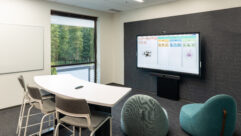
The Evolution of Conference Spaces
Mar 27, 2014 11:56 AM,
By Justin O’Connor
Can huddle rooms facilitate productivity?

Independent professional services firm of designers, planners, engineers, consultants and technical specialists, Arup, deployed Pexip Infinity scalable software platform worldwide. The deployment enables Arup’s 11,000 staff across 38 countries to use high-definition video, voice, and data collaboration, and will also be used to connect to Arup’s clients. Pexip’s conferencing nodes are virtual machines that can sit on either a VMware or Microsoft Hyper-V infrastructure making use of standard server architecture.
The globalization of today’s workforce and the rise of unified communication technologies have led to the reduction of traditional labor market borders. As a result, firms hire a greater number of offsite workers and are collaborating with remote stakeholders on a daily basis. This phenomenon is changing not only the way we communicate but also the structural design of the places where we communicate.
One such evolution affecting business infrastructure is the huddle room. Broadly defined, huddle rooms are small spaces found throughout a building where five or fewer people congregate for meetings—whether these spaces were originally designed as a meeting space or have been commandeered as such. These rooms provide much-needed privacy for office workers who are regularly exposed to the many disruptions of an open office setting. Office interiors are beginning to reflect this new behavior, leaning toward the creation of several small meeting spaces instead of traditional moderate to large conference rooms.
Technology is also contributing to the increase in huddle rooms. As the lines between consumer and business communication platforms blur, employee expectations of how they want to work impacts the manner in which these spaces are used. In addition to the benefits of reducing travel costs, augmenting work teams, and increasing productivity, huddle rooms—coupled with a variety of conferencing equipment—are also helping organizations become more efficient. By taking advantage of often leftover small spaces, or carving them out of larger existing spaces, huddle rooms provide employees a space to collaborate away from their desk, removing the noise factor common to an open-plan environment. This becomes especially important for large settings where hundreds or even thousands of employees interact; creating “soft” efficiencies that can positively influence earnings over time.
To take full advantage of a huddle room’s benefits, organizations need to take several factors into account. These include considerations related to the space design, selecting a suitable audio system, and installing adequate audio peripherals. By following best practices, organizations can avoid many of the common pitfalls that can limit the benefits of huddle room deployments.
It is increasingly common for many of today’s conferencing users to communicate with remotely located team members using a laptop and IP-based conferencing software. The simplicity of this solution, and the adoption of software like Skype and Facetime outside the office, has proven to be a driving force for the adoption of conferencing practices within the office. Some organizations have even begun equipping every employee workstation with videoconferencing capabilities in hopes of encouraging increased productivity. However, due to the rapid rise of this trend, the hastiness to engage their workforce, and the deluge of low-cost/lower-range solutions, many of the more important issues that can guarantee optimal conferencing experiences (which feeds into productivity) are being mistakenly overlooked or value-engineered out.
Since huddle rooms are often born out of necessity, many employees erroneously adopt a laptop or lower-quality speakerphone solution until the shortcomings of poor audio quality and latency issues begin to strain communications, cause fatigue and frustration, and stall collaborative momentum. When it comes to running meetings, poor audio also makes it more difficult to develop team cohesion. Attendees are forced to focus on comprehending remote participants and adjusting their speaking levels in order to be understood, leading to unnatural communication styles that can actually damage group synergy. Interestingly, meeting members exposed to ineffective audio tend to report more health ailments (headaches, irritability), find it more difficult to concentrate, and note a general lack of motivation.
Conversely, when conferences produce audio quality that mimics face-to-face interaction, more natural exchanges occur, leading to better teamwork and more productive meetings where participants experience a more natural flow of conversation and idea exchange. The following huddle room best practices are designed to increase the effectiveness of conference calls within huddle room spaces. While somewhat similar to the practices of larger boardrooms and medium-sized conference rooms, huddle room deployments vary in the scale of both setup size and investment.
First, the installation of a dedicated microphone will dramatically improve the experience for colleagues collaborating remotely. Contrary to speakerphone and embedded microphones on laptops or tablets, a professional-quality ceiling or tabletop microphone will result in crisper audio and reduced background noise. When installing microphones, integrators need to consider several factors. For instance, when deploying ceiling microphones, huddle room design specifications will greatly affect performance. In rooms with average to low-hanging ceilings, cardioid microphones with 120-degree pickup patterns are better adapted to capturing sound from a wider, lower span, which ensures that all voices can be heard. In huddle rooms with higher ceilings, designers should instead turn to supercardioid microphones, which boast a tighter pickup range of 90 degrees to better serve longer distances between the mic and the people speaking. Because ceiling microphones have a large pickup area, installers should also be careful not to “over-mic” a huddle room, which can cause severe audio degradation. Tabletop microphones should also be considered as another way of providing audio within the space.
Second, the loudspeaker should be carefully considered as it can also make an enormous contribution to meeting success and effectiveness. Loudspeakers can be installed directly into the ceiling or deployed as self-contained speakers to deliver both fidelity and wideband audio. When selecting a conferencing solution, consider all the spaces where the solution could potentially be used. The correct choice could result in having quality audio distributed across several huddle rooms within a facility, creating a more affordable investment rate per room. Some audio processing platforms can also be expanded modularly to accommodate growing organizations, which further contributes to cost effectiveness.
The third best practice for system selection is the provision of digital signal processing to eliminate noise from surrounding sources such as HVAC systems. Specific audio-enhancing features include automatic gain control, ambient noise compensation, gain sharing automixing, and acoustic echo cancelation, which eliminates the delay effect on conference calls that can severely disrupt the natural flow of conversations. Beyond eliminating unwanted noise, signal processing technology facilitates proper gain staging and clear audio, acoustic tuning for the room, and precise control of the system.
From an acoustic standpoint, huddle rooms offer leniency due to their smaller size. However, certain materials such as concrete floors and glass walls will add to the complications in producing high-quality audio. These surfaces reflect sound waves, producing reverberation, which in turn reduces intelligibility and makes it difficult for meeting participants to understand one another. By using acoustical modeling software, integrators can accurately analyze a space’s sound performance in order to create a pre-installation model that will identify potential short- and long-term sound reflections. The result is a clearer picture of which audio components and features to select in order to maximize a huddle room’s acoustic potential.
As conferencing spaces continue to evolve, two things remain clear: employees need to be able to hear colleagues clearly in order to collaborate successfully; and the fundamental guidelines of equipping these huddles rooms are no different from traditional conference rooms just because the space is smaller. Advanced technology, professional quality equipment, and proper system design practices will make these smaller spaces much more usable, thus adding to a team’s productivity.
Justin O’Connor is product manager, audio products for Biamp Systems.










